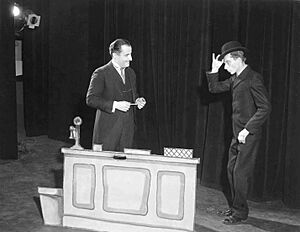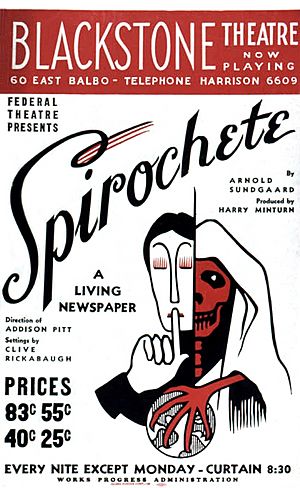Living Newspaper facts for kids

A Living Newspaper is a special kind of play that shares real facts about current events with a large audience. These plays often encouraged people to take action on social issues. They were different from traditional plays that tried to be super realistic. Instead, Living Newspapers used exciting, direct, and experimental ways to tell their stories, often including videos and sounds. This style first appeared in Russia during the Bolshevik Revolution.
The term "Living Newspaper" is most famous for the plays made by the Federal Theatre Project (FTP) in the United States. This project was part of a government program in the 1930s called the Works Progress Administration. The FTP created many Living Newspapers about important social topics of the time. Some famous ones include Triple-A Plowed Under, Injunction Granted, One-Third of a Nation, Power, and Spirochete. Some people disagreed with the political messages in these plays. This disagreement helped lead to the Federal Theatre Project closing down in 1939. Because of this, some Living Newspapers that were about to be performed, especially those dealing with race issues, never made it to the stage.
Contents
What Was the Federal Theatre Project's Living Newspaper?
The Living Newspaper program started very soon after the Federal Theatre Project (FTP) began. In 1935, Hallie Flanagan, who was in charge of the FTP, and playwright Elmer Rice planned how the project would work. This led to the creation of the New York Living Newspaper Unit. This group worked with the American Newspaper Guild. It hired many journalists and theater workers who had lost their jobs during the Great Depression. This gave them a chance to earn money.
Why Did Ethiopia Not Open?
The research team for the Living Newspaper Unit quickly put together their first play, called Ethiopia. Rehearsals began in 1936. However, the play never opened to the public. The government stopped it because it showed real leaders like Italian dictator Benito Mussolini on stage. The government had a rule against actors pretending to be heads of state. Elmer Rice left the FTP because he was upset about this decision.
Early Plays: Triple-A Plowed Under and Injunction Granted
After Ethiopia was canceled, the Unit quickly created another Living Newspaper called Triple-A Plowed Under. This play was about farmers struggling during the Dust Bowl. It suggested that farmers and workers should team up against "middlemen" like dealers. The "Triple-A" in the title referred to the Agricultural Adjustment Act of 1933, which the play criticized.
Like other Living Newspapers, Triple-A Plowed Under used special effects. It had a "Voice of the Living Newspaper" that narrated the story. It also used shadows, projected images, sound effects, music, and quick scene changes. These non-realistic methods kept the audience interested and helped share the play's message.
Another play, Events of 1935, was a collection of scenes from news events that year. It only ran for a short time and was not very successful.
The Unit's third play, Injunction Granted, was even more direct in its message. It made fun of powerful business leaders like Henry J. Heinz and newspaper owner William Randolph Hearst. The play encouraged workers to join the Congress of Industrial Organizations (CIO), a strong workers' group. The government was worried about this play even before it opened. Hallie Flanagan asked the director to change parts of it. However, the play still made it to the stage mostly as planned. Injunction Granted used over-the-top humor and clearly showed its opinion. For example, Heinz was shown holding a giant pickle. The play received a lot of criticism and closed early.
Success Stories: Power and One-Third of a Nation

After the problems with Ethiopia and Injunction Granted, the Living Newspaper Unit needed to be more careful. To keep getting government funding, they started choosing topics that were less politically extreme. However, they still focused on important social issues and called for change.
Their next play, Power, opened in 1937. It supported the New Deal policies and the Works Progress Administration. Power told the story of people looking for affordable electricity. It highlighted the Tennessee Valley Authority project as a good example of how to provide power. The play also introduced the "little man" character. This character represented the average person, asking questions and getting explanations throughout the play. Power was very popular. It ran for 140 performances and then traveled around the city for outdoor summer shows.
The next Living Newspaper was also a big hit. In 1937, Hallie Flanagan helped develop a play about housing problems. This play became One-Third of a Nation. It opened in 1938 and ran for 237 performances, making it the most successful Living Newspaper. This play was less experimental than earlier ones. It used a very realistic set to show the terrible conditions of a slum. But it still used the episodic format and multimedia elements like sound, film, and images. Critics praised the play, and it may have even helped pass new housing laws. It eventually opened in many major cities across the country.
The End of the Federal Theatre Project
Even with its growing success and less radical tone, the government's opinion of the Federal Theatre Project began to change in 1938. The House Un-American Activities Committee (HUAC) started investigating the FTP. They thought the project might be too political or supporting communism. Hallie Flanagan defended the FTP and the Living Newspapers. She said they were "propaganda for democracy, propaganda for better housing," not against the government. Despite her defense and President Roosevelt's objections, Congress closed down the FTP and the New York Living Newspaper Unit on July 30, 1939.
When the FTP closed, many Living Newspaper scripts were left unfinished or unperformed. This included three plays by African-American playwrights that dealt with race issues and racism. One was Liberty Deferred, which explored the history of slavery in the U.S. and lynchings of African-Americans in the South. Some historians believe Congress might have shut down the FTP partly to silence Black artists and their criticism of racism.
The Living Newspaper style has continued to influence theater today. For example, the DC Theatre Collective performed a piece called "The Tea Party Project" in 2010 that used this style.
Living Newspapers Outside New York
While the New York Living Newspaper Unit created most of the famous plays, other units in different U.S. cities also produced or planned their own. Often, these were local versions of the New York plays. Both Power and One-Third of a Nation were performed across the U.S. Their scripts were sometimes changed to fit local situations. In Seattle, the mayor even declared "Power Week" to celebrate the play Power. This was because the play's topic was very important there, as public and private power companies were competing for support.
Some units outside New York also researched and wrote their own Living Newspapers. For example, the Southwest Unit in California planned plays about historical land deals. Other units planned plays about timber, dirt, and historical flags. However, none of these regional Living Newspapers were fully produced.
But Chicago did create an original Living Newspaper called Spirochete. This play was very successful and had a big impact, similar to the later New York Living Newspapers.
How Were Living Newspapers Made?
Living Newspapers had certain common features, even though their exact definitions varied.
First, the content of a Living Newspaper always focused on a current event or issue that affected everyday Americans, especially the working class. This could be anything from bad housing conditions to the need for affordable electricity. Teams of researchers, many of whom were journalists without jobs, gathered a lot of facts for each play. Editors then organized this information and gave it to writers. The writers then put together the Living Newspaper using these facts, statistics, newspaper clippings, and stories. Even though Hallie Flanagan said Living Newspapers should be fair and unbiased, most of them clearly showed an opinion and encouraged the audience to take action.
Second, the FTP's Living Newspapers often broke away from realistic theater rules. They used experimental ways to tell their stories and design the stage. A guide from 1938 called "Techniques Available to the Living Newspaper Dramatist" listed many of these methods. These included:
- Quick scene and set changes.
- Flexible stage space, using different levels and moving scenery to show many places without big, fancy sets.
- Projecting settings, facts, and films.
- Shadow play.
- Sound effects and full musical scores.
- Using a loudspeaker to narrate and comment on the action.
- Sudden blackouts and bright spotlights.
The guide also suggested using puppetry, modern dance, and pantomime. For how the plays were put together, the guide advised writers to use "counterpoint." This meant quickly switching between scenes and voices that showed different viewpoints. This helped comment on the action and kept the audience involved and thinking.
Living Newspapers in Russia
The idea for Living Newspapers came from theater styles in Bolshevik Russia, Germany, and European workers' theater groups. Performances similar to Living Newspapers appeared in Russia as early as 1919. They used things like lantern slides, songs, newspaper readings, and film clips to share news and messages with people who couldn't read. As this style grew in Russia, workers' groups created local Living Newspapers about public issues. The Russian term for "Living Newspaper" is Zhivaya Gazeta. It was most popular from 1923 to 1928. Hallie Flanagan visited Russia in 1926 and saw these workers' performances. She was especially interested in the Blue Blouse theater groups. These groups used humor and difficult acrobatics to bring news to the public. The work of Russian theater artists Vsevolod Meyerhold and Vladimir Mayakovsky, and German artists Bertolt Brecht and Erwin Piscator, also influenced the Living Newspaper style.
|


